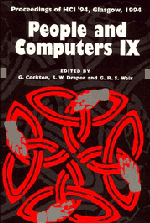Book contents
- Frontmatter
- Contents
- Preface: HCI'94 – You Probably Haven't Seen It All Before
- Part I Invited Papers
- Part II Methodology of Interactive Systems Development
- Crafting Interaction: Styles, Metaphors, Modalities and Agents
- Modelling Humans, Computers and their Interaction
- Notations and Tools for Design
- 22 XUAN: Enhancing UAN to Capture Temporal Relationships among Actions
- 23 Structured Notations to Support Human Factors Specification of Interactive Systems
- 24 Discount Dialogue Modelling with Action Simulator
- 25 Executable Task Analysis: Integration Issues
- 26 Beyond Data Models for Automated User Interface Generation
- Part VI Computer-Supported Cooperative Work
- Author Index
- Keyword Index
26 - Beyond Data Models for Automated User Interface Generation
Published online by Cambridge University Press: 04 August 2010
- Frontmatter
- Contents
- Preface: HCI'94 – You Probably Haven't Seen It All Before
- Part I Invited Papers
- Part II Methodology of Interactive Systems Development
- Crafting Interaction: Styles, Metaphors, Modalities and Agents
- Modelling Humans, Computers and their Interaction
- Notations and Tools for Design
- 22 XUAN: Enhancing UAN to Capture Temporal Relationships among Actions
- 23 Structured Notations to Support Human Factors Specification of Interactive Systems
- 24 Discount Dialogue Modelling with Action Simulator
- 25 Executable Task Analysis: Integration Issues
- 26 Beyond Data Models for Automated User Interface Generation
- Part VI Computer-Supported Cooperative Work
- Author Index
- Keyword Index
Summary
Researchers in the area of automated design of user interfaces have shown that the layout of an interface can, in many cases, be generated from the application's data model using an intelligent program that applies design rules. The specification of interface behavior, however, has not been automated in the same manner, and is mostly a programmatic task. Mecano is a model-based user-interface development environment that extends the notion of automating interface design from data models. Mecano uses a domain model — a highlevel knowledge representation that augments significantly the expressiveness of a data model — to generate automatically both the static layout and the dynamic behavior of an interface. Mecano has been applied successfully to completely generate the layout and the dynamic behavior of relatively large and complex, domain-specific, form- and graph-based interfaces for medical applications and several other domains.
Keywords: model-based interface development, automated interface design, interface models, domain models, data models.
Introduction
One of the areas that is receiving increased interest by researchers is that of model-based user interface development. This emerging technology is centered around the premise that a declarative interface model can be used as a basis for building interface development environments. The model-based approach facilitates the automation of the design and implementation of user interfaces.
In addition, researchers have shown that an application's data model can be used effectively to generate the static layout of an application's interface (de Baar, Foley & Mullet, 1992; Janssen, Weisbecker & Ziegler, 1993). However, data models have not been applied to the generation of interface behavior specifications.
In this paper, we present Mecano, a model-based interface development environment that extends the concept of generating interface specifications from data models.
- Type
- Chapter
- Information
- People and Computers , pp. 353 - 366Publisher: Cambridge University PressPrint publication year: 1994
- 12
- Cited by

